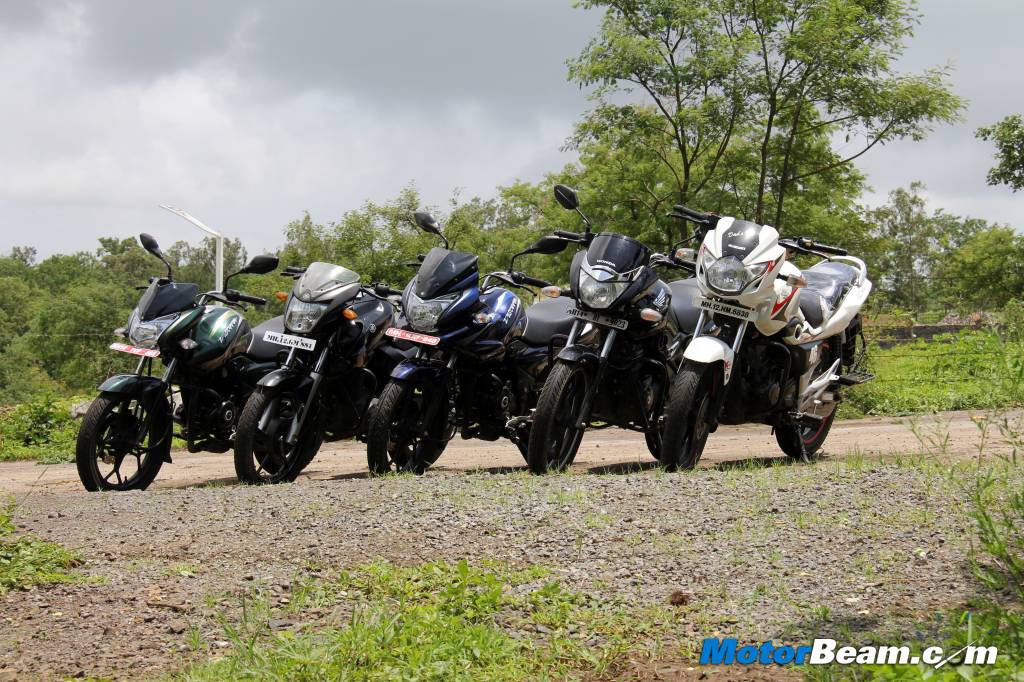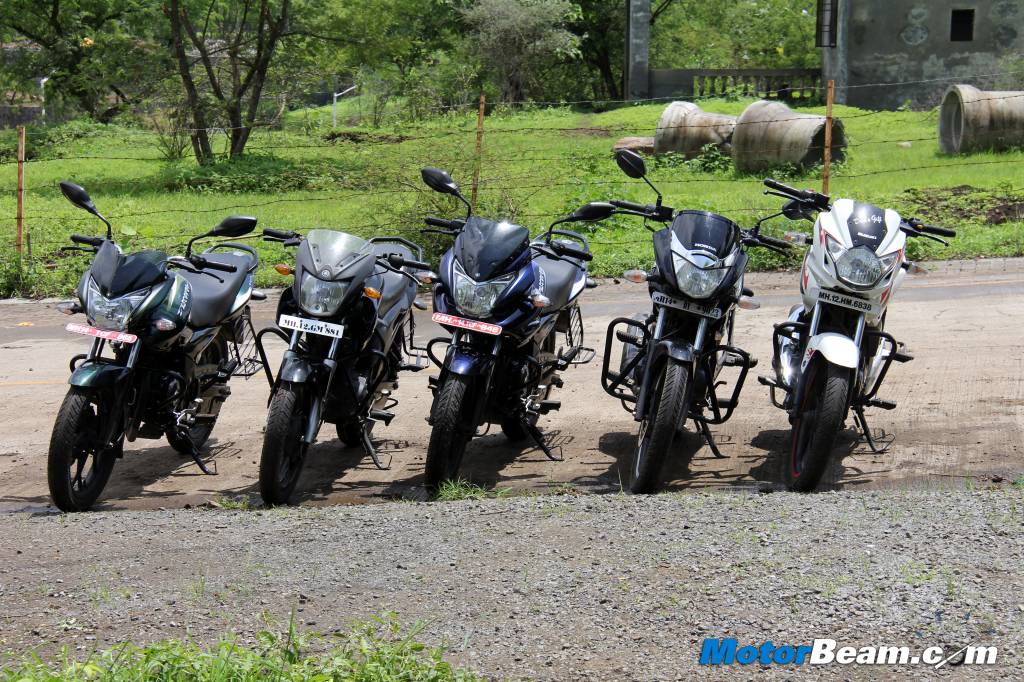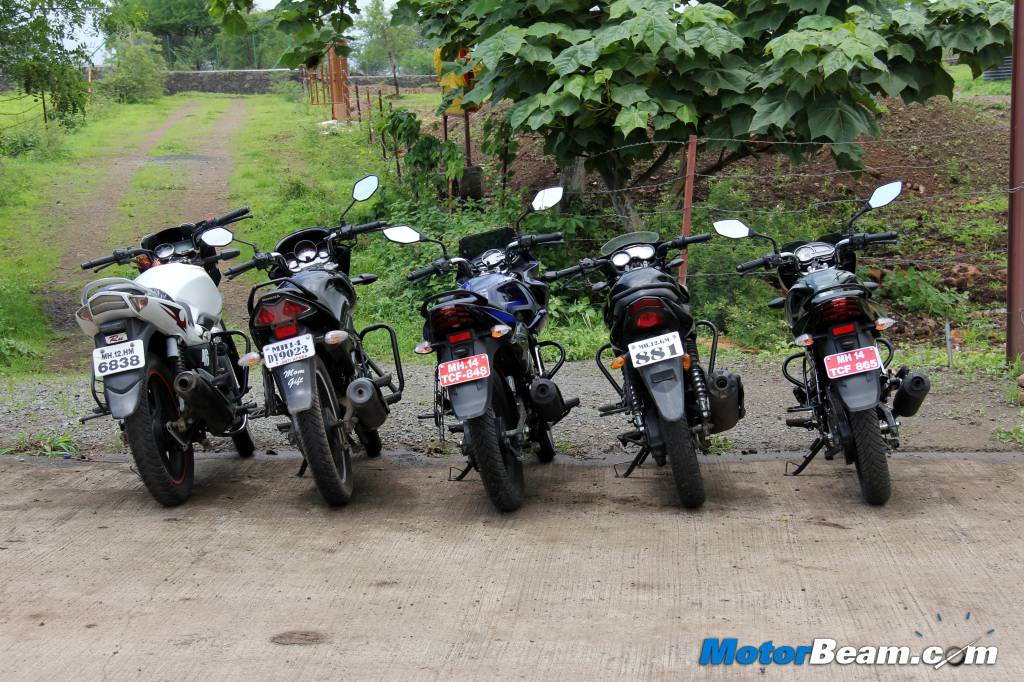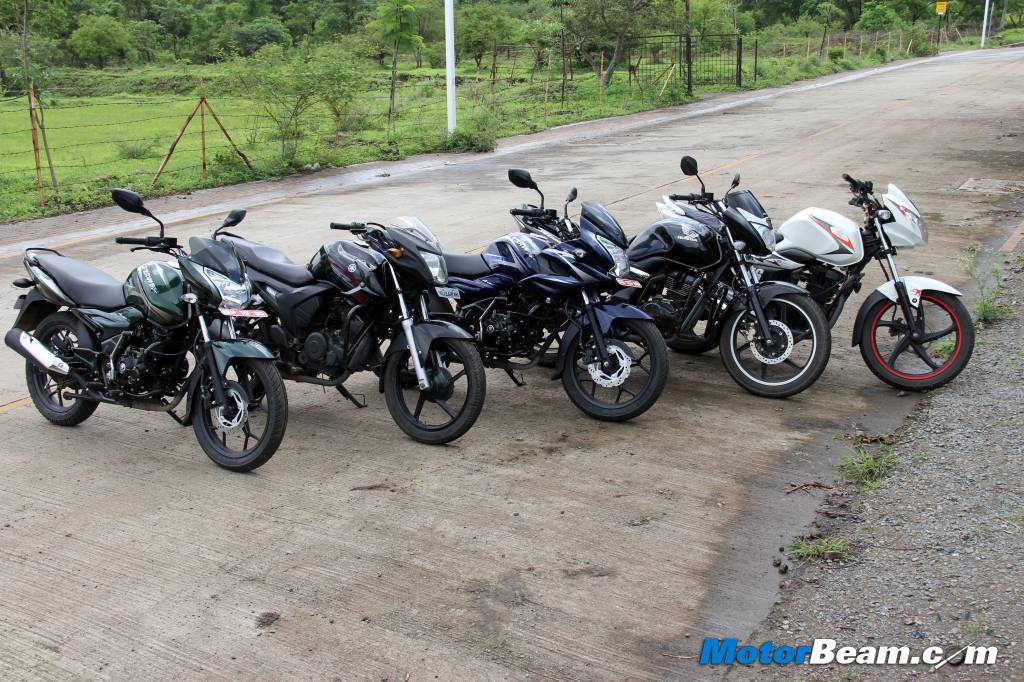
Shootout – Discover 150 F/S vs CB Unicorn vs SZ vs GS150R
Price OTR Mumbai: Rs. 60,659/- (Discover 150S Disc), Rs. 64,348/- (Discover 150F), Rs. 72,631/- (Yamaha SZ), Rs. 74,597/- (Honda Unicorn), Rs. 81,000/- (Suzuki GS150R)
Competition in the entry-level 150cc commuter segment in India is as intense as ever
Bajaj Auto was ahead of Honda in motorcycle sales in the domestic market until now. Honda overtook Bajaj by a mere 15,000 units and is now the #2 in motorcycle sales as well. Bajaj saw this coming and also saw that the 150cc segment is heating up like how super bike engines heat up in traffic. Bajaj is by far the strongest in the 150cc segment with the cult Pulsar 150 which impresses everybody and is on the mind of most motorcycle buyers. However, to strengthen that fact with a commuter version can work wonders. Hence the Bajaj Discover 150F and 150S come into the market. Bajaj is usually never late when it comes to replying to the competition. However, this time they are late to the party and they agree to this part. A segment where the Japanese have made two sub-segments of their own by offering two types of 150cc motorcycles in the market. A sporty one for you and me and a commuter one for me and the commuters. Bajaj seems to have an advantage in this situation as it is the last to enter in this segment because TVS will enter this segment sooner or later, as they are always last. Anyways, Bajaj has come up with a new Discover and it is the 150cc avatar this time. To challenge competitors, the Chakan based automaker has worked really hard and we were left seriously impressed when we recently road tested it. We were eager to put it through a comparison against the Japanese to find out if Bajaj has done a really good job because on paper it offers performance and value like no other. Is Bajaj going to become the ultimate king in the 150cc segment with this new Discover throwing away the competition? We find out by taking the tedious task into our hands. God speed to us, let’s go!


At the rear, all these 150cc motorcycles look substantial enough to justify their displacement and price
Styling – In terms of design all these motorcycles are good looking, have contemporary styling cues with them and there is no funky or sporty character anywhere and hence they are 150cc commuter segment machines. However, the most substantial of the lot are the Suzuki GS150R and Honda Unicorn with their huge wheels and humongous fuel-tank sizes and fat exhausts. The Discover 150 has the right proportion of them all with a well-sized muscular tank, a good looking exhaust and a half fairing on the F variant which is the icing on the cake here. The 150S variant looks like any ordinary Discover but that long length and monoshock at the rear gives it a clean look like the Unicorn. The SZ and GS150R have twin sided shocks at the rear. The SZ manages to look purposeful, small and goes unnoticed in the crowd. The SZ is the one which got recently refreshed with a bikini fairing and colours. Meanwhile, the Unicorn and the GS150R, oh dear, not updated since more than half a decade. Suzuki did some colour options in between, but Honda seems so scared that if they introduce a colour extra also, something will happen to the sales of the Unicorn.

The front look of the Yamaha SZ is great with that R15 inspired windscreen, the one on the GS is also pleasing but the CB Unicorn feels dated meanwhile the Discover as we saw in the road test, looks perfectly well done with the 150F variant. All motorcycles are well built, they are tanks of the motorcycle world with good build quality when it comes to using sheet metal and fibre. Fit-finish too is top notch on all these motorcycles. Bajaj has one edge over in this area and that is the well done graphics and as always an excellent paint job. Overall, the Discover 150 has the right cues as it has the sporty look in some angles and is fresh when it comes to the overall contemporary styling package which has not been refreshed since ages.
Ergonomics – Ergonomics is where all these motorcycles excel very well. All of them have upright riding position with tall and narrow handlebars. All of these bikes offer the lowest seat height possible to the customer in which the SZ scores the highest marks for having the lowest riding position and rest of them following the same except the Unicorn which comes last. All of these bikes have long seats which are well cushioned to suit both short and long journeys. The Discover’s seat is well cushioned too but the USP is that it is by far the longest here, not just in this segment but in the entire commuter motorcycle business. Discovers also score high on comfort because of the mid foot-peg positioning while rest of them have slightly rear-set pegs. Mirrors are well positioned on all these bikes but on the Discover 150F, they could have been mounted on the fairing for better visibility. Needless to say, they are not bad but could have been better.
The Yamaha SZ comes last, then comes the CB Unicorn followed by the Discover 150S which scores high marks
Instrument Cluster and Switchgear – Let’s be honest with the Honda Unicorn and Yamaha SZ here. Both look good but the Unicorn is terribly dated but makes for it by having a tachometer. The SZ though, is the one which is quite sporty in this picture and on the new refreshed version as well but still lacks a tachometer. However, none of these motorcycles have two trip meters, solitary turn indicators or any extra essentials over the two remaining motorcycles. Switch gear yet again on the Honda is disappointing as the other two Japanese competitors offer an engine kill switch. Bajaj also lacks an engine kill switch and has switches that don’t feel as good as other Bajaj bikes. The GS150R and SZ score full marks here, no doubt.
The GS150R has a digital console with a proper tachometer, the Discover does similar but without a tachometer
Suzuki is not known for making good clusters but has done the best job in the business here. Segment first gearshift indicator with a digital speedometer and an analogue tachometer is present with regular essentials. The GS150R is the only bike with solitary turn indicators but none of the compared bikes have it. Clearly the GS150R wins this round. The one on the Discover 150F is quite refreshing to the eye with a segment first service due indicator, battery indicator and regular tell-tale lights with a speedometer in between which is placed to look like a tachometer and does the needle salute as well.
Performance – Let us start with on paper figures. The Discover 150 has the most power of the lot with the best power to weight ratio by a good margin which is enough to make it win. However, it is slightly less on displacement and the power and torque it creates is on the upper part of the power-band due to 4-valves breathing instead of 2-valves which is on its competitors. This leads to the fact that the competitors make power and torque lower in the power-band. However, yet again, the Discover 150’s gearing is on the shorter side and rest of the rivals are tall geared. Which means on paper, the Discover 150 wins but that is not the true story, right? As you all know, we have ridden these bikes back to back to tell you who scores high and where. Let’s come to the part on how they feel.
All these motorcycles have smooth and refined engines and gearbox but the GS150R is the only bike here with a 6-speed transmission. Yes, now the Discover also comes in this category. Those who have read our road test would know what we are talking about. The Suzuki motor is the distinct of the lot as always with a cracker of an engine that sounds and feels so good that you can rev it all day long. It is also possible due to the taller gearing on the GS150R which produces good figures like the Unicorn but none of these two motorcycles feel sprightly like the Discover 150. The SZ comes close because it has the same old carburettor engine of the FZ with the exact same gearing but only the overdrive gear is shorter which makes overtaking in top gear much better but it has the lowest power and torque figures, despite weight being on the lighter side (still not as light as the Discovers). The Yamaha is the only motorcycle after the Discover which comes close in terms of city drivability. Needless to say all these motorcycles top out around the 108 km/hr mark when we VBOX tested them. Gearing is very similar on the Unicorn and the GS150R but when it comes to similarities between the Discover, it is the SZ that has short gear ratios like the Bajaj. If you thought the FZ had the shortest gearing in the segment, the Discover beats it. This is what we came to know when we compared their gear ratios on paper which obviously translates on the road as well. That is one of the reasons why despite the Discover having the most power, torque and 4-valves, it does not have a good top speed as premium 150cc motorcycles. Conclusion, none of these bikes comes close to the Discover which feels the most sprightly, torquey and wins the performance crown in this segment.
Fuel economy king are the Discovers with the GS150R, SZ and CB Unicorn finishing behind in that very order
When it comes to NVH, the Discover 150 has no vibes throughout the rev band except at the top-end where it is slightly boomy and vibrates. However, that is way lesser than previous variants which already had good NVH than the first generation Discovers. The typical Japanese engines vibrate a bit just before they make torque but are smooth and vibe free throughout the power-band. In terms of fuel economy, the Discover 150 has the highest fuel economy on the highway and in the city while offering class leading drivability. The Discover 150 offers 55 km/l in the city and 60 km/l on highway. The SZ offers 50 km/l in the city and 55 km/ on highway. The Unicorn never goes above 55 km/l and in the city manages only 47 km/l while the GS150R is quite similar to the Honda in terms of efficiency. Clearly the Discover 150, as always with any Bajaj product in its stable, is the leader in mileage numbers despite riding hard and fast, the bike only requires time to time service to deliver these excellent numbers to you.
Riding Dynamics – If a Yamaha product comes into a comparison, we know who is going to win this test. Yamaha simply never rolls out a product from its factory which is not dynamically better than the competition by miles. The Yamaha simply wins this part as it has the best chassis, dynamics, low weight, short wheelbase and front-end geometry. The Suzuki GS150R handles well too but the twin shock setup is on the softer side and at the limit you start feeling the weight which brings us to the Honda CB Unicorn that also feels the same in this aspect. The Discover 150 though, with the shortest wheelbase and the lightest kerb weight in the segment coupled with the peppy engine is much more fun to ride than all the competition. The chassis has been revised well and it helps the already impressive and agile Discover be even better in every aspect which includes ride and stability. Like the scooters as well, the Yamaha comes first in dynamics but when combined to the engine as a complete package, the Discover wins it because as an overall package, it is the most fun to ride machine. A similar analogy we told when we compared the Yamaha Ray to the Suzuki Let’s, if you remember.
The Suzuki GS150R and Honda Unicorn ride and handle well but they are not fun and don’t like to be dragged to the limit to give the rider the fun he looks for when the going gets twisty. In terms of braking, the Discover comes second with good initial bite than before and has a petal disc too. But it is the Yamaha which scores slightly higher marks in this department. The GS150R and Unicorn’s braking is good too, there is nothing to complain. Ride quality is fantastic on these motorcycles and this is where all of them score good marks. However, if we wanted to rank some one #1 in this test for having a plush ride quality over the others, it has to be the Suzuki GS150R.
After Sales and Service Experience – Most people know that we have said in our previous reports that we have been living with products from Bajaj, Suzuki, Yamaha and Honda and we got to experience the service of these manufacturers. Yamaha offers one of the cheapest service bills for every stablemate and that undercuts Honda by a good margin. Honda service attitude is quite frankly the worst. With high spare part pricing and unruly/rude technicians and managers at service centres making the case even worse. Suzuki on the other hand offers even more cheaper service cost than Yamaha and service is quite good too. Bajaj service as we all know is great and the reach is enormous. With spare parts and servicing cost very low compared to competition, it makes running cost of the Discover 150 a less expensive affair (better fuel efficiency too) by a healthy margin.
Verdict – Let’s get straight to the point. Bajaj is fighting the bikes that are proven products which don’t go wrong easily. However, over time and time, a Bajaj peculiarity, the ongoing process of making things better keeps on going. We are told that these learnings have already gone into other products and what we complained about other motorcycles is already rectified. If you read our review of the Discover 150 F/S, you will know that how these products are extremely refined than before, offering the best in class performance, mileage and drivability. When it comes to the next crucial aspect which is value, the faired version of the Discover 150 undercuts the lowest Japanese competitor by Rs. 9000/-, which is a lot of money for a person who is looking for a budget performance commuter.
If you think nothing can shake the Honda CB Unicorn, then you are wrong. You cannot get the Unicorn at the price mentioned above because the waiting period is enormous and unauthorised sub-dealers charge you an extra sum of money to get the bike for you which is usually around Rs. 5000/-. So if you can wait for a dated product for more than four months or are willing to pay more, than you have a good bike but the extra price you pay is totally not worth it. The drum variant of the Discover 150S (not recommended) is similarly priced as the 125 ST (now discontinued) and still undercuts the 125cc offerings from the Japanese competitors. Bajaj seems to have nailed it yet again with value but there are things which they are lacking like long term reliability and resale value. We just hope that the new promising nature of Bajaj stays for a long time and the company remains committed to its products and customers. However as a product alone, the Discover 150 beats all its Japanese rivals. Still, if you want one of the Japanese bikes, it’s the Suzuki GS150R which is the best of the rest and it feels every inch worth the premium you pay over the Unicorn.
The Discovers cannot be beaten on parameters such as performance, styling and value at any given point. The Japanese offer reliability but in a basic package. Bajaj gets close to parameters offered by the competition and hence the Discover 150 is easily the winner and the better product in this test.
Further Reading –
Bajaj Discover 150 F/S Review
Suzuki GS150R Review
Riders – Saurabh Sutar, Amit John, Viraj David, Omkar Jadhav, Prasad Jadhav, Swapnil Jadhav.




